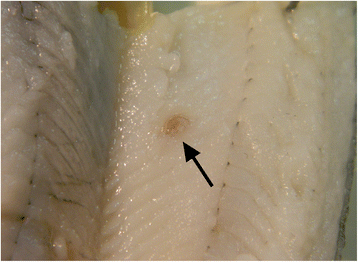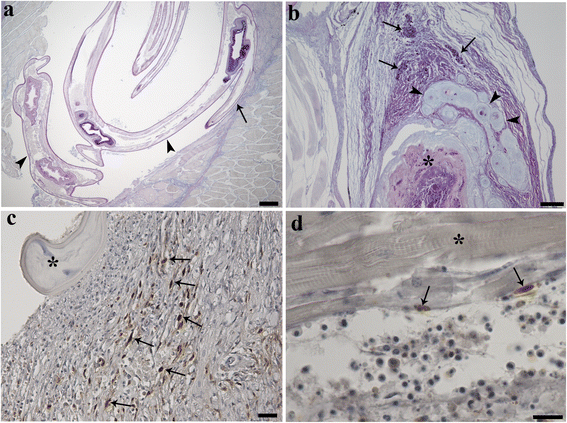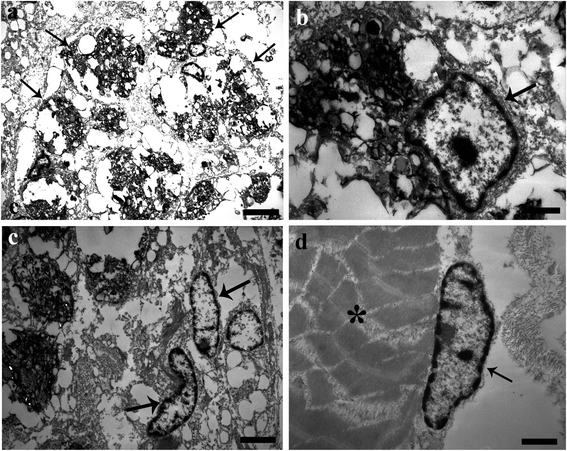Histopathology and the inflammatory response of European perch, Perca fluviatilis muscle infected with Eustrongylides sp. (Nematoda)
- PMID: 25889096
- PMCID: PMC4404125
- DOI: 10.1186/s13071-015-0838-x
Histopathology and the inflammatory response of European perch, Perca fluviatilis muscle infected with Eustrongylides sp. (Nematoda)
Abstract
Background: The European perch, Perca fluviatilis L. is a common paratenic host of dioctophymatid nematodes belonging to the genus Eustrongylides. In this host, once infected oligochaetes, which serve as the first intermediate host, are ingested, Eustrongylides migrates through the intestine and is frequently encountered within the musculature, free within the body cavity, or encapsulated on the viscera. The current study details the first Italian record of Eustrongylides sp. with larvae reported in the muscle of P. fluviatilis.
Methods: Uninfected and nematode-infected muscle tissues of perch were fixed and prepared for histological evaluation and electron microscopy. Some sections were subjected to an indirect immunohistochemical method using anti-PCNA, anti-piscidin 3 and anti-piscidin 4 antibodies.
Results: A total of 510 P. fluviatilis (TL range 15-25 cm) from Lake Trasimeno, Perugia were post-mortemed; 31 individuals had encysted nematode larvae within their musculature (1-2 worms fish(-1)). Histologically, larvae were surrounded by a capsule with an evident acute inflammatory reaction. Muscle degeneration and necrosis extending throughout the sarcoplasm, sarcolemmal basal lamina, endomysial connective tissue cells and capillaries was frequently observed. Within the encapsulating reaction, macrophage aggregates (MAs) were seen. Immunohistochemical staining with the proliferating cell nuclear antigen (PCNA) revealed numerous PCNA-positive cells within the thickness of the capsule and in the immediate vicinity surrounding Eustrongylides sp. larvae (i.e. fibroblasts and satellite cells), suggesting a host response had been initiated to repair the nematode-damaged muscle. Mast cells (MCs) staining positively for piscidin 3, were demonstrated for the first time in response to a muscle-infecting nematode. The piscidin 3 positive MC's were seen principally in the periphery of the capsule surrounding the Eustrongylides sp. larva.
Conclusions: A host tissue response to Eustrongylides sp. larvae infecting the musculature of P. fluviatilis was observed. Numerous fibroblasts, MAs and MCs were seen throughout the thick fibroconnectival layer of the capsule enclosing larvae. PCNA positive cells within the capsule suggest that host repair of nematode damaged muscle does occur, while the presence of the antimicrobial peptide piscidin 3 is shown for the first time. This is first report of Eustrongylides sp. in an Italian population of P. fluviatilis.
Figures



Similar articles
-
OCCURRENCE OF EUSTRONGYLIDES EXCISUS (NEMATODA:DIOCTOPHYMATIDAE) IN EUROPEAN PERCH (PERCA FLUVIATILIS) AND GREAT CORMORANT (PHALACROCORAX CARBO) IN LAKE ANNONE, NORTHERN ITALY.J Parasitol. 2022 Mar 1;108(2):209-216. doi: 10.1645/20-175. J Parasitol. 2022. PMID: 35435986
-
Perch liver reaction to Triaenophorus nodulosus plerocercoids with an emphasis on piscidins 3, 4 and proliferative cell nuclear antigen (PCNA) expression.Vet Parasitol. 2014 Feb 24;200(1-2):104-10. doi: 10.1016/j.vetpar.2013.11.023. Epub 2013 Dec 4. Vet Parasitol. 2014. PMID: 24360655
-
Piscidins in the intestine of European perch, Perca fluviatilis, naturally infected with an enteric worm.Fish Shellfish Immunol. 2013 Nov;35(5):1539-46. doi: 10.1016/j.fsi.2013.08.023. Epub 2013 Sep 5. Fish Shellfish Immunol. 2013. PMID: 24012748
-
Occurrence of Parasites of the Genus Eustrongylides spp. (Nematoda: Dioctophymatidae) in Fish Caught in Trasimeno Lake, Italy.Ital J Food Saf. 2016 Nov 15;5(4):6130. doi: 10.4081/ijfs.2016.6130. eCollection 2016 Sep 20. Ital J Food Saf. 2016. PMID: 28058245 Free PMC article.
-
Morphological and Molecular Characterization of Larval and Adult Stages of Eustrongylides excisus (Nematoda: Dioctophymatoidea) with Histopathological Observations.J Parasitol. 2019 Dec;105(6):882-889. J Parasitol. 2019. PMID: 31738125
Cited by
-
Infection of endemic chub Squalius tenellus with the intestinal tapeworm Caryophyllaeus brachycollis (Cestoda): histopathology and ultrastructural surveys.Parasitology. 2024 Feb;151(2):157-167. doi: 10.1017/S0031182023001233. Epub 2023 Dec 1. Parasitology. 2024. PMID: 38193283 Free PMC article.
-
First Occurrence of Eustrongylides spp. (Nematoda: Dioctophymatidae) in a Subalpine Lake in Northwest Italy: New Data on Distribution and Host Range.Int J Environ Res Public Health. 2020 Jun 11;17(11):4171. doi: 10.3390/ijerph17114171. Int J Environ Res Public Health. 2020. PMID: 32545332 Free PMC article.
-
Eustrongylides spp. parasite risk management in Atherina boyeri from Lake Trasimeno.Ital J Food Saf. 2023 Aug 7;12(3):11338. doi: 10.4081/ijfs.2023.11338. eCollection 2023 Aug 2. Ital J Food Saf. 2023. PMID: 37753206 Free PMC article.
-
The Occurrence of Freshwater Fish-Borne Zoonotic Helminths in Italy and Neighbouring Countries: A Systematic Review.Animals (Basel). 2023 Dec 8;13(24):3793. doi: 10.3390/ani13243793. Animals (Basel). 2023. PMID: 38136832 Free PMC article. Review.
-
Histopathological, morphological, and molecular characterization of fish-borne zoonotic parasite Eustrongylides Excisus infecting Northern pike (Esox lucius) in Iran.BMC Vet Res. 2024 Jul 4;20(1):291. doi: 10.1186/s12917-024-04146-0. BMC Vet Res. 2024. PMID: 38965518 Free PMC article.
References
-
- Moravec F. Parasitic Nematodes of Freshwater Fishes of Europe. Revised Second Edition. Hardback, Academia: Praha; 2013.
Publication types
MeSH terms
LinkOut - more resources
Full Text Sources
Other Literature Sources
Medical
Miscellaneous

